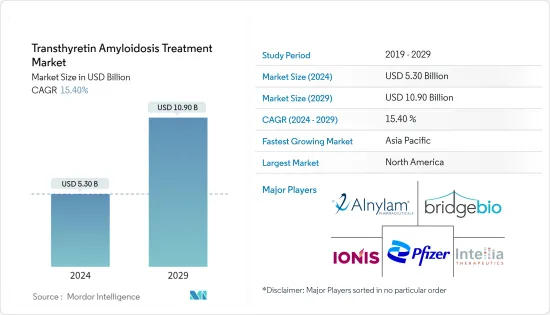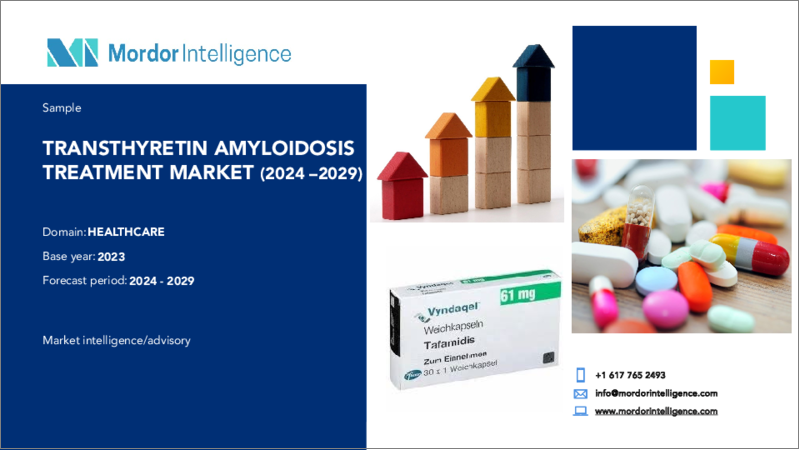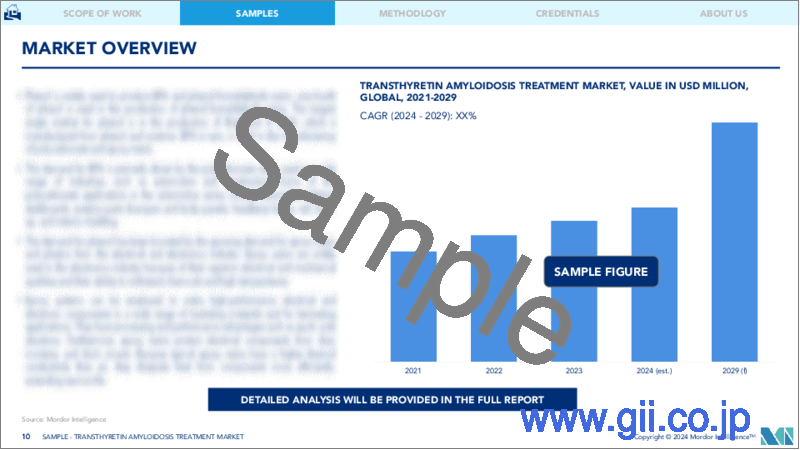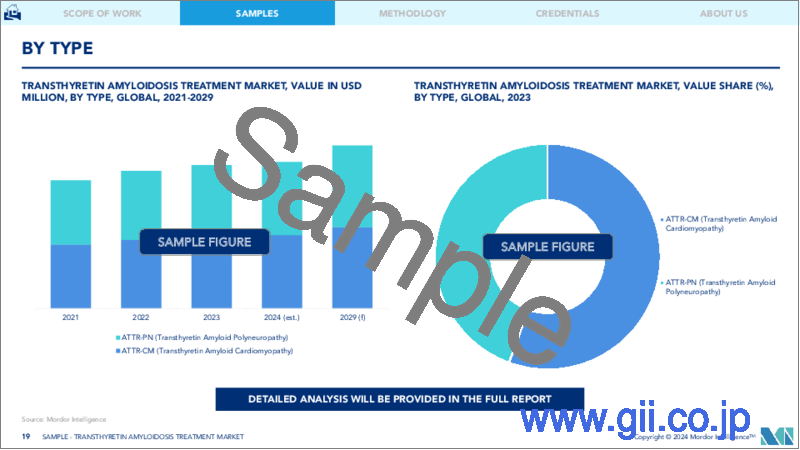|
|
市場調査レポート
商品コード
1521788
トランスサイレチン型アミロイドーシス治療:市場シェア分析、産業動向、成長予測(2024年~2029年)Transthyretin Amyloidosis Treatment - Market Share Analysis, Industry Trends & Statistics, Growth Forecasts (2024 - 2029) |
||||||
カスタマイズ可能
適宜更新あり
|
|||||||
| トランスサイレチン型アミロイドーシス治療:市場シェア分析、産業動向、成長予測(2024年~2029年) |
|
出版日: 2024年07月15日
発行: Mordor Intelligence
ページ情報: 英文 120 Pages
納期: 2~3営業日
|
全表示
- 概要
- 目次
トランスサイレチン型アミロイドーシス治療市場規模は、2024年に53億米ドルと推計され、2029年には109億米ドルに達すると予測され、予測期間中(2024-2029年)のCAGRは15.40%で成長する見込みです。

トランスサイレチン型アミロイドーシス治療市場は、高齢者人口の増加やアミロイド軽鎖(AL)の危険因子の増加、研究開発(R&D)の増加、一般市民の疾患に対する意識の高まりなどにより、大きな成長が見込まれています。加齢は、体内のタンパク質構造と機能の変化に関連しています。主に肝臓で産生される輸送タンパク質であるトランスサイレチンは、時間の経過とともにミスフォールディングを起こします。このミスフォールディングは、異常なタンパク質の凝集体が形成されて組織に蓄積し、臓器の機能障害を引き起こすアミロイドーシスの発症に重要な因子です。
さらに、形質細胞の異常を特徴とする形質細胞異常症は、アミロイドーシスの亜型であるアミロイド軽鎖(AL)アミロイドーシスの危険因子として知られています。多発性骨髄腫のような疾患も含め、形質細胞異常症の発症リスクは、高齢になるほど形質細胞の機能や増殖に異常が生じやすくなる傾向があります。例えば、WHOが2023年10月に発表したデータによると、WHO欧州地域では2024年までに65歳以上の人口が15歳未満の人口を上回ると推定されています。このことは、若年層に比べて高齢層が多いことを示しており、アミロイド軽鎖(AL)アミロイドーシスのリスクを高める可能性があるため、調査期間中の市場成長を後押しします。
さらに、研究開発の増加と疾患に対する意識の高まりも、トランスサイレチン型アミロイドーシス治療市場の成長を促進する重要な要因です。製薬企業やバイオテクノロジー企業は、トランスサイレチン型アミロイドーシスの革新的な標的治療を開拓するために、研究開発に多額のリソースを投入しています。例えば、2024年2月、アストラゼネカは、トランスサイレチン介在性アミロイド心筋症(ATTR-CM)の成人患者を対象としたアコラミジスの日本での第III相臨床試験の良好な結果を報告しました。同様に、2023年3月には、イオニス・ファーマシューティカルズが、遺伝性トランスサイレチン介在性アミロイドポリニューロパチー(ATTRv-PN)治療用のアンチセンス薬であるエプロンターセンの新薬承認申請(NDA)を食品医薬品局(FDA)に受理されたことを報告しました。これらの事例は、トランスサイレチン型アミロイドーシスの治療に関する研究開発の成長を示しており、予測期間中に市場が大きく成長することが期待されます。
したがって、老人人口の増加、ALの危険因子、研究開発活動の増加は、トランスサイレチン型アミロイドーシス治療市場の成長を促進するいくつかの主要な要因です。しかし、この治療に関連する高コストは、予測期間中、市場を抑制すると予想されます。
トランスサイレチン型アミロイドーシス治療市場動向
予測期間中、遺伝性トランスサイレチン型アミロイドーシスセグメントが大きなシェアを占める見込み
遺伝性トランスサイレチン型アミロイドーシス(hATTR)は、トランスサイレチン(TTR)遺伝子の変異に起因する、末梢(体性および自律神経系)障害の蔓延を伴う稀で重篤な異種の多系統疾患です。遺伝性トランスサイレチン型アミロイドーシス(hATTR)は、その遺伝性の特性により、標的治療の努力に一貫した特定可能な患者基盤を提供することから、大きな市場シェアを占めると予想されます。このセグメントの成長を促進する要因としては、啓発プログラムによるhATTRの認知度向上、研究投資の増加、製品の入手可能性を高めるパートナーシップ、製品承認、発売などの市場プレイヤーの戦略などが挙げられます。
疾患に対する意識の高まりは、効果的な治療に対する需要を高めるため、このセグメントの成長を大きく後押しします。ヘルスケア専門家や一般市民が、症状、危険因子、診断の進歩に関する知識を深めるにつれて、積極的な管理が重視されるようになっています。例えば、アルナイラム社は2024年3月、遺伝性ATTR(hATTR)アミロイドーシスの発症リスクを理解するため、家族間で健康歴について主治医と会話することを奨励する「家族健康歴ロードトリップ」を開始しました。このような啓発は、様々な製品を用いた早期診断と治療に役立つため、調査期間中の同分野の成長を後押ししています。
さらに、提携や製品承認のような市場プレイヤーの戦略は、市場での製品の入手可能性を高め、それによってセグメントの成長を後押しします。例えば、2024年1月、アストラゼネカとイオニスは、遺伝性トランスサイレチン介在性アミロイドポリニューロパチーの治療薬としてFDAに承認されたWAINUA(エプロンターゼン)の独占的専門薬局パートナーとしてOrsini Specialty Pharmacyを選定しました。さらに2022年8月、アルナイラム・ファーマシューティカルズ・インクは、遺伝性トランスサイレチン・アミロイドーシスによる神経痛に使用できるオンパトロがFDAに承認されたと発表しました。このような戦略的活動により、製品の入手可能性が高まり、予測期間中の同分野の成長が促進されると期待されます。
したがって、市場プレイヤーの認知度向上と戦略的活動により、遺伝性トランスサイレチン型アミロイドーシス分野は予測期間中に大きな市場シェアを占めると予想されます。
予測期間中、北米が市場最大シェアを記録する見込み
北米は、先進的なヘルスケアインフラやトランスサイレチン型アミロイドーシス疾患の罹患率の増加などの要因により、市場で最大のシェアを占めると予想されます。確立された研究能力、研究開発への投資拡大、臨床試験インフラが同地域の市場成長を牽引しています。
トランスサイレチン型アミロイドーシス(ATTR)に対する先進的治療製品の開発への新たな投資は、市場成長を後押しすると期待されています。例えば、2023年5月、米国国立衛生研究所(NIH)は、ATTRアミロイドーシス治療薬開発の進展に向けて、アミロイドーシス研究コンソーシアムに4万米ドルを授与しました。これらの要因は、予測期間中の市場成長を促進すると予想されます。
さらに、製品承認や規制当局からの積極的な勧告など、市場プレイヤーの戦略が成長することで、この地域における治療製品の使用量が増加します。例えば、2024年4月、Alnylam Canada ULCは、CADTH(Canadian Agency for Drugs and Technologies in Health)から、AMVUTTRA(vutrisiran injection)の償還について肯定的な勧告を受けました。同様に2023年10月、AMVUTTRAは、遺伝性トランスサイレチン介在性アミロイドーシス(hATTRアミロイドーシス)の成人患者におけるステージ1またはステージ2のポリニューロパチーの治療薬として、カナダでの販売が承認されました。したがって、積極的な推奨と承認は、この地域における製品の使用と入手可能性を増加させ、それによって予測期間におけるこの地域の市場成長を後押しします。
トランスサイレチン型アミロイドーシス治療業界の概要
トランスサイレチン型アミロイドーシス治療市場は、世界的および地域的に事業を展開する限られた企業の存在により、その性質上、適度に統合されています。競合情勢には、Pfizer Inc.、Ionis Pharmaceuticals、Alnylam Pharmaceuticals Inc.、Intellia Therapeutics Inc.、BridgeBio Inc.など、市場シェアを持ち知名度の高い国際企業や地元企業の分析が含まれます。
その他の特典:
- エクセル形式の市場予測(ME)シート
- 3ヶ月間のアナリストサポート
目次
第1章 イントロダクション
- 調査の前提条件と市場定義
- 調査範囲
第2章 調査手法
第3章 エグゼクティブサマリー
第4章 市場力学
- 市場概要
- 市場促進要因
- 老年人口の増加とアミロイド軽鎖(AL)の危険因子
- 研究開発(R&D)の増加と疾患に対する意識の高まり
- 市場抑制要因
- トランスサイレチン型アミロイドーシス治療に伴う高コスト
- ポーターのファイブフォース分析
- 新規参入業者の脅威
- 買い手/消費者の交渉力
- 供給企業の交渉力
- 代替品の脅威
- 競争企業間の敵対関係の強さ
第5章 市場セグメンテーション(市場規模-金額)
- タイプ別
- ATTR-CM(トランスサイレチン型心アミロイドーシス)
- ATTR-PN(トランスサイレチン型家族性アミロイドポリニューロパチー)
- 治療法別
- 標的療法
- 支持療法
- 疾患タイプ別
- 遺伝性アミロイドーシス
- 野生型アミロイドーシス
- その他の疾患タイプ
- 販売チャネル別
- 病院薬局
- 小売薬局
- その他の流通チャネル
- 地域別
- 北米
- 米国
- カナダ
- メキシコ
- 欧州
- ドイツ
- 英国
- フランス
- イタリア
- スペイン
- その他欧州
- アジア太平洋
- 中国
- 日本
- インド
- オーストラリア
- 韓国
- その他アジア太平洋地域
- 世界のその他の地域
- 北米
第6章 競合情勢
- 企業プロファイル
- Pfizer Inc
- Ionis Pharmaceuticals
- Alnylam Pharmaceuticals Inc.
- BridgeBio Inc
- Intellia Therapeutics Inc.
- Prothena
- Alexion Pharmaceuticals
- Millennium Pharmaceuticals
- Corino Therapeutics Inc.
- Takeda Pharmaceutical Company Limited
- Oncopeptides
- SOM BIOTECH
第7章 市場機会と今後の動向
The Transthyretin Amyloidosis Treatment Market size is estimated at USD 5.30 billion in 2024, and is expected to reach USD 10.90 billion by 2029, growing at a CAGR of 15.40% during the forecast period (2024-2029).

The transthyretin amyloidosis treatment market is expected to grow significantly due to the growing geriatric population and risk factors for the amyloid light chain (AL), increasing research and developments (R&D), and raising public disease awareness. Aging is associated with changes in the body's protein structure and function. Transthyretin, a transport protein primarily produced in the liver, undergoes misfolding over time. This misfolding is a critical factor in the development of amyloidosis, where abnormal protein aggregates form and accumulate in tissues, leading to organ dysfunction.
In addition, plasma cell dyscrasia, a condition characterized by abnormal plasma cells, is a known risk factor for amyloid light chain (AL) amyloidosis, a subtype of amyloidosis. The risk of developing plasma cell dyscrasias, including conditions like multiple myeloma, tends to increase as older individuals are more susceptible to abnormalities in plasma cell function and proliferation. For instance, according to the data published by the WHO in October 2023, the population of individuals aged over 65 years is estimated to outnumber those under the age of 15 years in the WHO European region by 2024. This shows a significant number of people in the aging population compared to those of a young age, which may increase the risk of amyloid light chain (AL) amyloidosis, thereby boosting market growth over the study period.
Furthermore, increasing R&D and growing disease awareness are other significant factors driving the growth of the transthyretin amyloidosis treatment market. Pharmaceutical and biotechnology firms are committing substantial resources to R&D to pioneer innovative and targeted treatments for transthyretin amyloidosis. For instance, in February 2024, AstraZeneca reported positive high-level results from the Japan Phase III trial of acoramidis in adults with transthyretin-mediated amyloid cardiomyopathy (ATTR-CM). Similarly, in March 2023, Ionis Pharmaceuticals reported the acceptance of a New Drug Application (NDA) for eplontersen, an antisense medicine for the treatment of hereditary transthyretin-mediated amyloid polyneuropathy (ATTRv-PN) by the Food and Drug Administration. These instances show the growing R&D on treating transthyretin amyloidosis, which is expected to have significant growth in the market over the forecast period.
Therefore, the growing geriatric population, risk factors for AL, and increasing R&D activities are some major factors driving the growth of the transthyretin amyloidosis treatment market. However, the high cost associated with this treatment is expected to restrain the market over the forecast period.
Transthyretin Amyloidosis Treatment Market Trends
The Hereditary Transthyretin Amyloidosis Segment is Expected to Hold a Significant Share Over the Forecast Period
Hereditary transthyretin amyloidosis (hATTR) is a rare and severe, heterogeneous multisystem condition with prevalent peripheral (both somatic and autonomic) nervous system impairment due to mutations in the transthyretin (TTR) gene. Hereditary transthyretin amyloidosis (hATTR) is expected to hold a significant market share due to its hereditary characteristics, providing a consistent and identifiable patient base for targeted therapeutic endeavors. The factors driving the growth of this segment include growing awareness of hATTR through awareness programs, growing research investments, and market player strategies like partnerships, product approvals, and launches, which increase the availability of the products.
The increasing disease awareness significantly drives the segment growth as it increases the demand for effective treatments. As healthcare professionals and the general public become more informed about the symptoms, risk factors, and diagnostic advancement related to conditions, there is a growing emphasis on proactive management. For instance, in March 2024, Alnylam Pharmaceuticals Inc. launched the Family Health History Road Trip to encourage conversations between family members about their health history with their doctor to understand their risk for developing hereditary ATTR (hATTR) amyloidosis. This awareness helps in early diagnosis and treatment of the disease using various products, thereby boosting segment growth over the study period.
Furthermore, the strategies of market players, like partnerships and product approvals, increase the availability of the products in the market, thereby boosting segment growth. For instance, in January 2024, AstraZeneca and Ionis selected Orsini Specialty Pharmacy as the exclusive specialty pharmacy partner for WAINUA (eplontersen), an FDA-approved treatment for adults living with hereditary transthyretin-mediated amyloid polyneuropathy. In addition, in August 2022, Alnylam Pharmaceuticals Inc. stated that the FDA approved Onpattro, which can be used for nerve pain caused by hereditary transthyretin amyloidosis. These strategic activities are expected to increase the availability of the products and boost the segment growth over the forecast period.
Therefore, due to the growing awareness and strategic activities of market players, the hereditary transthyretin amyloidosis segment is expected to hold a significant market share over the forecast period.
North America is Expected to Record the Largest Share in the Market Over the Forecast Period
North America is expected to have the largest share in the market due to factors such as advanced healthcare infrastructure and the increasing incidence of transthyretin amyloidosis disease in the region. Established research capabilities, growing investments for research and development, and clinical trial infrastructure are driving the region's market growth.
New investments in developing advanced treatment products for transthyretin amyloidosis (ATTR) are expected to boost the market growth. For instance, in May 2023, the National Institutes of Health (NIH) awarded the Amyloidosis Research Consortium with USD 40,000 toward advancing ATTR amyloidosis drug development. These factors are expected to propel the market growth over the forecast period.
Additionally, growing market player strategies, such as product approvals and positive recommendations from the regulatory authorities, increase the usage of treatment products in the region. For instance, in April 2024, Alnylam Canada ULC received a positive recommendation for reimbursement from the Canadian Agency for Drugs and Technologies in Health (CADTH) for AMVUTTRA (vutrisiran injection). Similarly, in October 2023, AMVUTTRA was authorized for sale in Canada to treat stage 1 or stage 2 polyneuropathy in adult patients with hereditary transthyretin-mediated amyloidosis (hATTR amyloidosis). Hence, the positive recommendations and approvals increase the usage and availability of products in the region, thereby boosting the region's market growth over the forecast period.
Transthyretin Amyloidosis Treatment Industry Overview
The transthyretin amyloidosis treatment market is moderately consolidated in nature due to the presence of limited companies operating globally as well as regionally. The competitive landscape includes an analysis of a few international as well as local companies that hold market shares and are well known, including Pfizer Inc., Ionis Pharmaceuticals, Alnylam Pharmaceuticals Inc., Intellia Therapeutics Inc., and BridgeBio Inc.
Additional Benefits:
- The market estimate (ME) sheet in Excel format
- 3 months of analyst support
TABLE OF CONTENTS
1 INTRODUCTION
- 1.1 Study Assumptions and Market Definition
- 1.2 Scope of the Study
2 RESEARCH METHODOLOGY
3 EXECUTIVE SUMMARY
4 MARKET DYNAMICS
- 4.1 Market Overview
- 4.2 Market Drivers
- 4.2.1 Growing Geriatric Population and Risk Factors for Amyloid Light Chain (AL)
- 4.2.2 Increasing Research and Development (R&D) and Growing Disease Awareness
- 4.3 Market Restraints
- 4.3.1 High Cost Associated with the Transthyretin Amyloidosis Treatment
- 4.4 Porter's Five Forces Analysis
- 4.4.1 Threat of New Entrants
- 4.4.2 Bargaining Power of Buyers/Consumers
- 4.4.3 Bargaining Power of Suppliers
- 4.4.4 Threat of Substitute Products
- 4.4.5 Intensity of Competitive Rivalry
5 MARKET SEGMENTATION (Market Size by Value - USD)
- 5.1 By Type
- 5.1.1 ATTR-CM (Transthyretin Amyloid Cardiomyopathy)
- 5.1.2 ATTR-PN (Transthyretin Amyloid Polyneuropathy)
- 5.2 By Therapy
- 5.2.1 Targeted Therapy
- 5.2.2 Supportive Therapy
- 5.3 By Disease Type
- 5.3.1 Hereditary Amyloidosis
- 5.3.2 Wild-type Amyloidosis
- 5.3.3 Other Disease Type
- 5.4 By Distribution Channel
- 5.4.1 Hospitals Pharmacy
- 5.4.2 Retail Pharmacies
- 5.4.3 Other Distribution Channel
- 5.5 Geography
- 5.5.1 North America
- 5.5.1.1 United States
- 5.5.1.2 Canada
- 5.5.1.3 Mexico
- 5.5.2 Europe
- 5.5.2.1 Germany
- 5.5.2.2 United Kingdom
- 5.5.2.3 France
- 5.5.2.4 Italy
- 5.5.2.5 Spain
- 5.5.2.6 Rest of Europe
- 5.5.3 Asia-Pacific
- 5.5.3.1 China
- 5.5.3.2 Japan
- 5.5.3.3 India
- 5.5.3.4 Australia
- 5.5.3.5 South Korea
- 5.5.3.6 Rest of Asia-Pacific
- 5.5.4 Rest of the World
- 5.5.1 North America
6 COMPETITIVE LANDSCAPE
- 6.1 Company Profiles
- 6.1.1 Pfizer Inc
- 6.1.2 Ionis Pharmaceuticals
- 6.1.3 Alnylam Pharmaceuticals Inc.
- 6.1.4 BridgeBio Inc
- 6.1.5 Intellia Therapeutics Inc.
- 6.1.6 Prothena
- 6.1.7 Alexion Pharmaceuticals
- 6.1.8 Millennium Pharmaceuticals
- 6.1.9 Corino Therapeutics Inc.
- 6.1.10 Takeda Pharmaceutical Company Limited
- 6.1.11 Oncopeptides
- 6.1.12 SOM BIOTECH






